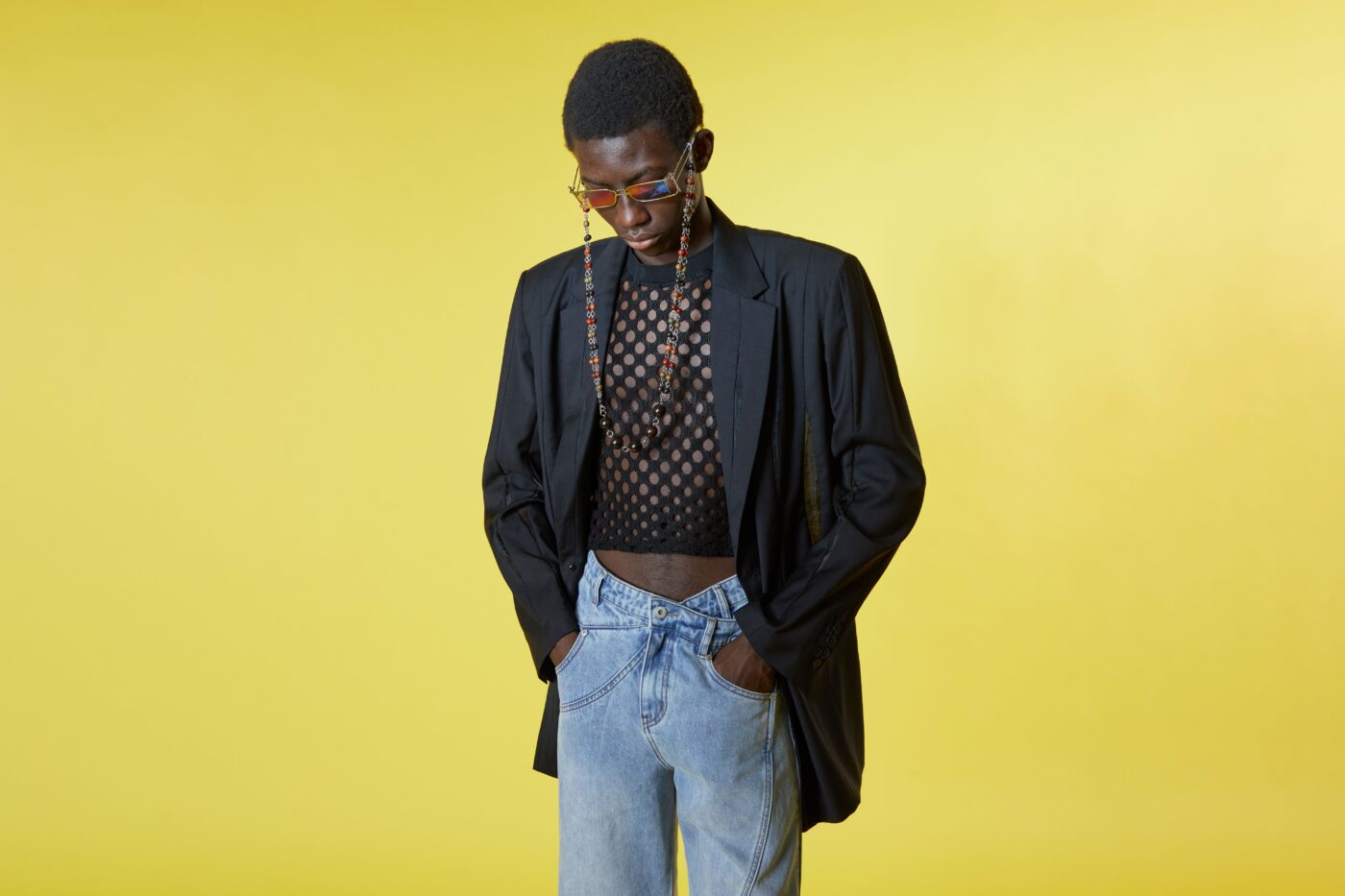Fashion
The young London fashion designers changing the way we dress

While Paris and Milan nurture covetable couture, if you want to spark hope for fashion’s future, there’s no better place to look than London. The capital has long been a hotbed for emerging designers who go on to make an indelible mark on fashion history. Think Alexander McQueen, Jonathan Anderson and recent Met Gala favourite John Galliano. And one look at the fashion moves currently taking place in the city will assure you, the future is indeed stacked with creative talent. The new guard of designers in London is championing thoughtful design and ethical practices in addition to producing clothes that are just plain fabulous. From frothy diaphanous creations and sexy technical knitwear to politically driven garments, meet the London fashion designers changing the way we dress.
Bianca Saunders
Bianca Saunders wants to revolutionise men’s fashion. Since graduating from her MA in Fashion Menswear at the Royal College of Art in 2017, and launching her label the same year, Saunders has stamped her mark on the genre, adopting a gender-bending approach with her designs. At Saunders’ shows, it’s common to see male models stomping the runway in sheer and ruched materials and figure-hugging cuts – they don cropped tops and side-split trousers. And yet, the garments are eminently wearable. It’s a balance that has earned the Catford-born designer accolades ranging from the British Fashion Council’s ‘One to Watch’ designation, to becoming the first black woman to win the Andam prize (an award established between the French Ministry of Culture and the Defi Mode fashion organisation).
Saunders’ Jamaican heritage is also key in shaping her designs: prints and silhouettes are inspired, she has said, by the black men in her life, like her father and grandfather. The draped styles recall dancehall parties in London. In short, her work is about juxtaposition: of the masculine and feminine, of Caribbean cool and British edge.
Visit biancasaunders.com
Molly Goddard
Molly Goddard believes that wearers of her clothes should feel “comfortably overdressed”, which perfectly encapsulates the nature of her always OTT, but never severe, garments. The poofy, diaphanous pieces – which range from frothy tulle frocks to ruffled silk smocks – are reminiscent of the 1950s sheath styles that were repurposed in the punk era, and have proved a hit with high-profile clientele.
Goddard’s orange-and-yellow striped cardigan was immortalised when David Hockney painted Harry Styles wearing one. Ditto a Calpol-pink babydoll dress worn by Jodie Comer’s Villanelle in Killing Eve. Rihanna has been a fan since she posted a picture of herself wearing an enormous tiered Goddard gown in cobalt blue; others include Adwoa Aboah, Zendaya and Agyness Deyn, whose wedding dress the designer created in 2015. Goddard’s distinctive manipulation of fabric, cast in a crayon-box colour palette, has firmly established the London-born designer on the international fashion map.
Visit mollygoddard.com
Feng Chen Wang
Chinese-born, London-based designer, Feng Chen Wang, creates unisex garments that are simultaneously conceptual, technical and functional. Her designs are forward-thinking, cast in futuristic silhouettes and featuring deconstructed details. It’s a point of view that feels fresh, which explains Wang’s rapid ascent: a year after graduating from the Royal College of Art in 2015, she was debuting at New York Fashion Week, and has since been
a permanent, celebrated fixture on the roster. Wang has collaborated with brands such as UGG, earned a nomination for the LVMH Prize, and been a finalist in the International Woolmark Prize.
The designer’s heritage informs her designs: she has created sustainable tie-dye techniques based on Chinese ingredients, and even integrated principles of the bodily meridians (the belief in traditional Eastern medicine that there are ‘passageways’ of energy in the body, and the guiding principle behind acupuncture) into her clothes.
Visit fengchenwang.com
Saul Nash
Unlike many of his peers, Saul Nash didn’t follow the Central-Saint-Martins-to-own-label pipeline. Instead, when the north east Londoner graduated from his BA in Performance Design at CSM, he moved into dance. Eventually, in 2018, Nash received a scholarship to the eminent RCA Menswear MA, and established his eponymous brand the same year. But it is his background in dance – and a deep-rooted understanding not just of movement and the body, but also the codes of masculinity – that informs his designs.
Nash makes technical garments created for movement. This means he takes cues from sportswear, but to describe the pieces as ‘athleisure’ would be reductive. Nash’s styles are fluid and relaxed; mesh fabrics meet asymmetric hems and bold colourways. They’re often showcased via dance performances; indeed, Nash’s fashion regularly co-exists with music, and he has worked on choreography and videos for the likes of Neneh Cherry and Bianca Saunders.
Visit saulnash.co.uk
Sinéad O’Dwyer
Sinéad O’Dwyer is one of the most pioneering designers on the scene, routinely sending plus-sized, wheelchair-using and pregnant models down the runway. They’re often clad in her trademark silicone-moulded clothing; vibrantly-hued ‘wearable sculptures’ that refuse to hide or minimise parts of the body considered ‘less than’: stomach rolls, ‘love handles’, cellulite. O’Dwyer creates pieces that accommodate all bodies – no-one is precluded from wearing crystal-embellished bras, nipple pasties or thigh-high leather boots in her universe.
O’Dwyer’s work rails against normative beauty standards, and explores the often tense relationship that women have with their bodies. “I’m angry at the industry for its body elitism,” the Irish-born designer once told Dazed magazine. “I’ve seen it cause practically every woman I have ever known to view their bodies in a negative way due to poorly fitting garments, or comparison to… airbrushed imagery.” O’Dwyer is the change; disrupting the status quo from the inside.
Visit sineadodwyer.com
Chet Lo
If you thought that knitwear was about cosy jumpers or tweedy cardigans, Asian American Chet Lo will prove you spectacularly wrong. He catapulted to fashion fame after listing ‘spiked’ garments from his Central Saint Martins BA Knitwear course “to make rent”, and was inundated with orders. The textural pieces captured the zeitgeist: fun, sexy, nostalgic. They also showcase talent. Creating 3D prongs with a pair of knitting needles? Wow.
No surprise, then, that Lo’s graduate show received rave reviews. Or that he went on to join the roster of young talent at Fashion East, as well as the British Fashion Council’s NEWGEN scheme.
The designer has created bespoke pieces for Kylie Jenner, and American singers Doja Cat and SZA donned the pink spikes in the music video for smash hit Kiss Me More. Lo’s work is a composite of raw skill (you don’t intern at Maison Margiela and Proenza Schouler by chance), a love of Noughties fashion, and a distinct Eastern influence – he’s obsessed, he has told Vogue, with “old Japanese comics and the Godzilla visuals”.
Visit chetlo.com
Susan Fang
Susan Fang’s ethereal creations have been gaining popularity since the launch of her eponymous womenswear brand in 2017, following her graduation from Central Saint Martins and stints at Céline and Stella McCartney. Fang’s garments and accessories play with traditional ideas of beauty – the textures are sumptuous, the colours candy-like, and the silhouettes classic. But there’s more than prettiness at play here; consider a Susan Fang gown up close and you’ll notice just how mind-bendingly complex the construction is.
This is because Fang’s designs take inspiration from the natural world, and, more specifically, the mathematical processes that underpin it.
The Chinese-Canadian designer claims not to be led by trends, but by a desire to ‘express a mirage of artistic illusions’; she is fascinated by patterns and fractals – mathematical formulas that allow nature to create more beauty than we, as humans, could hope to conceive.
Visit susanfangofficial.com
Thebe Magugu
Thebe Magugu had to fight for his place on the fashion stage: the South African was rejected from Central Saint Martins, enrolling instead at fashion school in Johannesburg. The launch of his label was beset with difficulties but, in 2016, Thebe Magugu the brand was born. The designer’s breakout moment came when he created a capsule collection for Woolworths, which was showcased at South African Fashion Week. In 2019, Magugu became the first African to win the LVMH Prize. Today, his bold prints, silky textures and retro-inflected silhouettes are known the fashion world over.
What sets Magugu apart, however, are the political narratives that he weaves (literally) into his designs. He might print family photos onto his garments or create a collection from the plastic travel bags commonly used by Ghanaians deported from Nigeria, as he did in 2022. So committed is Magugu to creating dialogues around his home continent that he is willing to make financial sacrifices to keep the business there, saying, “I want to give back to my country and keep the brand local for as long as possible.”
Visit thebemagugu.com
Read more: Why bio-textiles are the future of fashion










